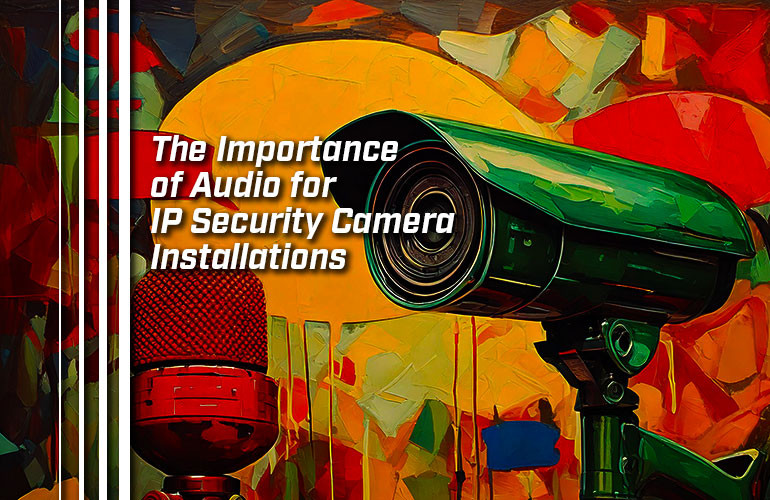When you think about IP cameras, you probably think about video. Which makes sense: they’re video cameras, after all.
But sometimes, the audio part of an IP camera is just as important.
Think of the difference between watching a silent film and a talkie (to use the old-fashioned term). Hearing what people are saying makes a big, big difference.
Using a microphone input, you can add an extra layer of security, providing more detailed evidence. Using a speaker output, you can broadcast alerts, warning vandals that they’re being watched.
In two-way audio setups, having both a microphone and speaker will let you use an IP camera essentially as a video intercom.
But there’s more to it than just this.
Let’s get into it!

Introduction to Audio for IP Cameras
Here’s how the audio for IP camera situation breaks down:
Some IP cameras support audio and have a built-in microphone and/or speaker. These cameras streamline installation and reduce overhead when compared with using accessory devices.
Other IP cameras support audio, but don’t come with a microphone or speaker. In this case, you need to buy and connect a compatible microphone and/or speaker.
The expansion microphone will be internal or external. Internal microphones are mounted inside the camera chassis. External microphones are typically connected directly via a 3.5 mm (AUX) cable or through the network via the IP camera system. An external mic is useful, because you can place it just where you need it, instead of having a mic inside the camera itself.
The expansion speaker will be external. It will usually be a network paging speaker of some type, linked to the camera via the IP camera system. This is convenient, because you don’t need to have the speaker right where the camera is: again, optimal placement.
With both situations, you’ll need to enable audio via the video management system (VMS) you’re using. With a professional IP camera VMS, you’ll have a variety of options like live-view audio, alert triggering, and so on.
Finally, still other IP cameras don’t support audio at all. For this blog, we can ignore these.

One-Way Audio vs Two-Way Audio
Audio for IP cameras can be one-way or two-way. Here, the terminology gets a bit complicated.
One-way audio will sometimes be called simplex. It means that the camera is setup to do one thing at time: intake audio using an internal or external microphone or output audio using an internal or external speaker. In this setup, it will not do both. Simplex audio is used to add sound to a video recording or live video stream or to make the attached speaker into an alarm.
Two-way audio will often be called duplex. It means the camera can both intake and output audio using an internal or external microphone and speaker.
With IP cameras, there are two types of duplex: half-duplex and full-duplex. Half-duplex means that the audio travels in one direction at a time, like a walkie-talkie or Push-To-Talk (PTT) setup. One side at a time speaks, the other listens. Full-duplex means the audio travels in both directions at the same time, like a phone call. Both sides can speak and listen at the same time.

Live-View Audio and Recorded Audio
When do you want to use audio with IP cameras?
IP cameras are used in two ways: for live surveillance and for recorded surveillance. Audio for IP cameras works the same way. In addition, you can also connect an IP camera with your paging system to use it to broadcast alerts.
If you enable two-way audio for live-view, you can speak with a customer at a fuel pump, warn a vandal that they’re being watched, check in on what’s happening in the store, and so on.
Two-way audio also lets you use an IP camera as part of a video intercom setup for more secure door entry control. For example, Viking Electronics offers the Viking MSB-30, which is, in essence, a stainless steel intercom designed for use with an IP camera, making the communications process simpler and improving audio quality when compared with a typical IP camera internal mic/speaker.
If you enable audio for recordings, you get more effective evidence than audio-less recordings. Be aware, though that audio will add to bandwidth and storage requirements.
Depending on the video management software you’re using, you can even add advanced protection like motion-activated alarms.
You can use an IP camera as a motion detector to trigger an alert using a speaker or loud ringer like the Axis D4100-E Network Strobe/Siren. You can program the speaker to broadcast a pre-recorded message or alert tone when the IP camera detects movement. You can even do this with a thermal camera, which detects heat, so it can accurately trigger alerts in any lighting or environmental condition.

Disabling Audio
We’ve talked up audio for IP cameras, but sometimes you don’t need or want it. If your camera comes with a microphone, will it always be on?
Not to worry: Because IP cameras are network connected and are managed via the video management system using a browser-based or desktop application, you’ll be able simply to select the audio off option from the management portal.
The exact steps for doing this vary depending on the platform, so we can’t give an all-encompassing example. Just search the user manual of the VMS software for the audio section, and it should be a simple couple of steps.

